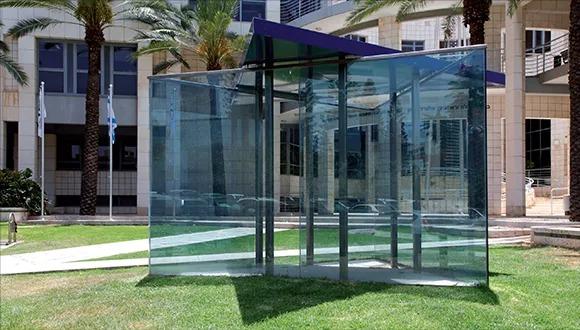Star of David Pavilion in Tel Aviv | Dan Graham
This pavilion was preceded by two other Star-of-David pavilions: one in Hamburg (1989) and the other in Vienna (1991-1996). In both, Graham’s use of the Jewish symbol was also a protest by the American-Jewish artist against antisemitism in those places.
About the Work and the Creator / Shira Kleinhauz and Asia Arutyunov
The Star of David Pavilion in Tel Aviv (1999) is a part sculptural, part architectural piece made of two triangles that together form a Star of David. Located between the Administration and Senate Buildings, it is composed of three rectangular slabs made of two-way reflective glass attached in their short sides to form a triangular prism of equal faces, with a rectangular roof above it. A glass sliding door is located in one edges, allowing access to the pavilion.
The pavilion's triangular basis is made of solid concrete where six aluminum rods are planted, supporting a blue aluminum roof. The triangular roof's shape is identical to the foundation in shape but faces in the opposite direction, thereby creating the Star of David. This position of the roof triangle creates three little triangles that remain open.
The triangle dominates this work, but there is a contradiction between the voluminous triangular prism of the lower structure, which includes the concrete floor and glass walls, and the triangular roof that crosses it, which remains flat. Another contradiction is embodied in the pavilion's materials: between the opacity of the gray concrete floor and blue aluminum roof and the two-way glass walls that produce a variety of reflections according to the time of day and weather. The viewer inside and outside the pavilion can overlook the landscape beyond the pavilion, and at the same time see his own reflection and that of the view behind him and on both sides, in accordance with his location relative to the pavilion.
The pavilion's symbolic, official and institutional shape is conceptually matched with the buildings on both its sides: the Administration and Senate. Formally, however, its sharp geometric shape poses a contrast to the rounded façade of the Administration Building and to the rounded rear face of the Senate Building.

Using Jewish Symbols as a Form of Protest
This pavilion was preceded by two other Star-of-David pavilions: one in Hamburg (1989) and the other in Vienna (1991-1996). In both, Graham’s use of the Jewish symbol was also a protest by the American-Jewish artist against antisemitism in those places. All three are part of the Pavilions series started by Graham in the late 1970s. After pursuing photography, video art and performance art, with no formal art education, Graham began creating sculpture-like plastic objects that can also serve as architectural buildings, although they are not designed for prolonged stay.
In Star of David Pavilion in Tel Aviv, the fragile glass and the openings between the walls and the roof suggest its residential unfeasibility. This creates a tension between the work as a sculpture and the work as a structure, and between the symbolic image and the fragility of the materials producing it.
Graham’s pavilions are reminiscent of the minimalist sculptures of his time. His work Two Adjacent Pavilions (1978-1981) is made of two cubic pavilions attached to one another that form a two-way mirror. It is reminiscent of the mirror cubes designed a decade earlier by minimalist artist Robert Morris. In both cases, the viewer who walks around the sculptural elements is aware not only of the changing shape of the body itself, but also of the reflections formed on the glass or mirrors.
Graham considered Gordo Matta Clark the artist who initiated the dialogue between art and architecture in the field of architecture itself, rather than in traditional gallery space. Indeed, most of Graham’s pavilions are not placed between museum or gallery walls, but in open public spaces. And despite the fact that they are made of glass, Graham chooses to allow the viewers into the pavilions, which serve, as he puts it, also as "playgrounds".
Graham attaches great importance to the pavilion materials: metal and glass or two-way mirror. These are "pure" but also industrial materials, used by many artists since the early 20th century. Graham is interested in the history of the architectural usage of these materials: in the magnificent glass pavilions of the pastoral gardens of 18th and 19th century nobility and bourgeoisie to escape the overcrowded city; in early modern industrial glass and metal buildings such as the Chrystal Palace; and in present-day skyscrapers. The history of these building tells us that glass was designed to create an architectural space limited to a small group of powerful people, inaccessible to the public, despite the fact that what occurs there affects their lives.
Graham’s pavilions propose an alternative: a glass building open to all. They encourage visitors to take part in a game of reflections: their own, other visitors’ and those of the view around them, both outside and within the pavilion.
| Artist: | |
| Dan Graham | |
| Name: | |
| Star of David Pavilion in Tel Aviv, 1999 | |
| Location: | |
| Between the Administration and Senate Buildings | |
| On loan from the Tel Aviv Museum of Art |





